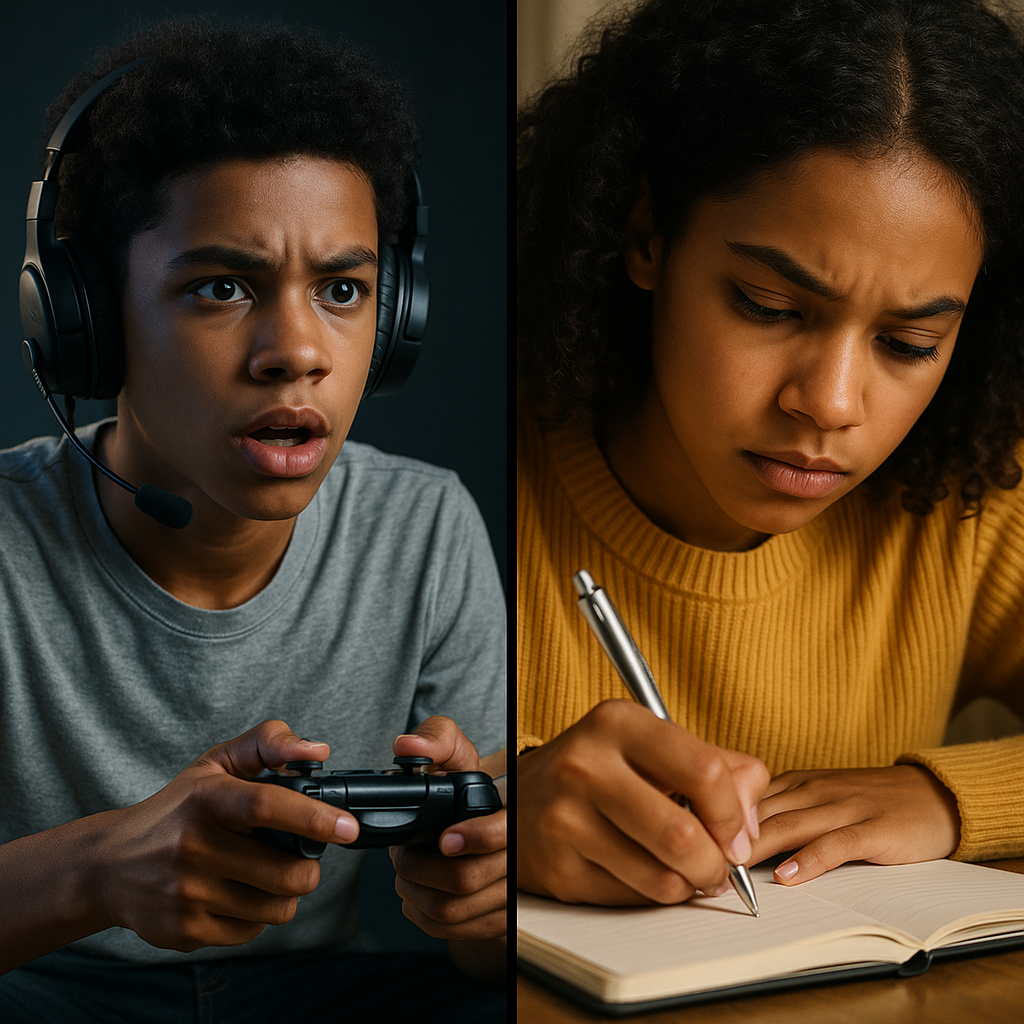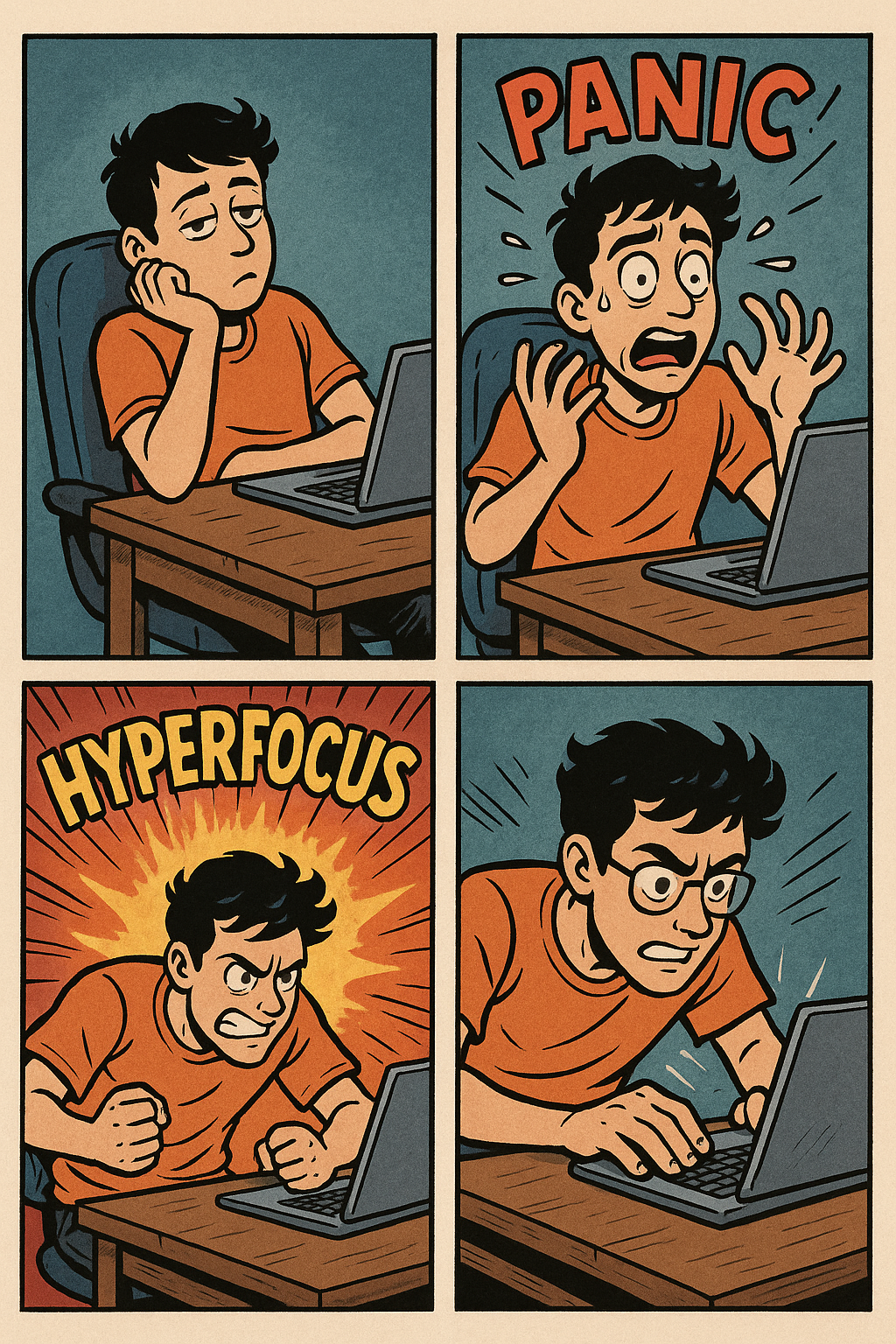not just a fancy word for cramming
You know that thing where someone becomes obsessed, can’t eat, can’t sleep, can’t shut up about it?
That’s not a phase. That’s hyperfocus. And it’s not some flaky, all-or-nothing party trick. It’s one of the most misunderstood and misused aspects of the neurodivergent brain. I’ve had a good portion in my younger life being told I’m lazy. A last-minute miracle merchant. You know the type.
And yet, somehow, I’ve managed to pull off projects that earn praise, meet deadlines I had no business meeting, and occasionally deliver a flash of brilliance that makes me look far more together than I actually am.
Enter: hyperfocus.
It’s not a trendy buzzword or an excuse for procrastination. It’s a real, often misunderstood neurological state. And if you’re neurodivergent like me, it might just be your superpower – if you learn how to wield it without burning yourself to ash.
In fact, if it were better recognised, we might be calling it what it truly is: a rare and powerful form of flow-state obsession that could rival elite athletes, academic prodigies, and CEOs… if only we’d stop treating it like a glitch.
What Is Hyperfocus and Why Does It Matter?
Let’s be clear: hyperfocus is not just good concentration.
It’s not mindfulness. It’s not meditation.
It’s more like obsession with blinkers on.
You don’t choose it. You don’t plan it.
It just happens – like falling into a tunnel and realising you’ve been in there for six hours, surviving on adrenaline and biscuit crumbs.
For many of us, especially those with ADHD or autistic traits, hyperfocus is where the magic happens. But it’s also where we forget to pee, forget to eat, and occasionally forget we live with other humans.
When Does Hyperfocus Start in Life?
It doesn’t start in adulthood with your fifth job and a half-written planner.
It starts in childhood.
Remember that time you spent hours building a Lego fortress? Or copying out every page of a book “just for fun”? That was hyperfocus.

It often goes unnoticed by adults. Why? Because we equate “focus” with paying attention in class, not silent immersion in a side project that makes no noise and demands no supervision.
Is Hyperfocus Gendered? Oh, Absolutely.
Boys who hyperfocus on trains or coding get labelled “bright” or “gifted”.
Girls who hyperfocus on emotional narratives, animals, or people’s behaviour? We get labelled “intense”, “dramatic”, or worse, “too much.”
Because many girls (and AFAB individuals) are socialised to mask, their hyperfocus often shows up in hidden, quiet ways:
- Diary writing
- People-watching
- Fixating on friendships
- Getting absorbed in creative detail
We weren’t seen as “gifted”. We were seen as obsessive. And that internalised shame followed us well into adulthood.
The Secret Link Between Procrastination and Hyperfocus

Here’s the twist no one talks about: hyperfocus is often triggered by panic.
I can coast for days in a fog of avoidance. And then – bam!
A deadline, a disaster, or a moment of sheer panic triggers a 12-hour binge of unstoppable productivity.
Sound familiar?
This isn’t laziness. It’s the ND brain needing a dopamine spike strong enough to override the fog. It’s fight-or-flight in spreadsheet form.
The Productivity Myth: Why Hyperfocus Isn’t Cheating
Hyperfocus looks impressive from the outside. It’s that one colleague who delivers a 20-slide presentation at 3am. The friend who writes a novel in two weeks. But what you don’t see is the crash afterward.
It’s not “cheating the system.” It’s sprinting in a world built for marathon runners.
After a bout of hyperfocus, many of us collapse. Mentally, emotionally, even physically. Because when you’re in it, you’re not just working, you’re merging with the task. And that kind of intensity isn’t sustainable on tap.
Why Hyperfocus Deserves More Respect
We treat hyperfocus like a dirty little secret. Like a messy cousin of productivity.
But in truth? It’s the engine behind so much unrecognised ND brilliance.
It’s the reason:
- Entire creative projects are born in a weekend
- ND entrepreneurs can build new systems from scratch
- Kids who can’t “sit still” can memorise encyclopaedias when inspired
We aren’t being flaky. We’re responding to a system that finally makes sense to our brains. When we’re interested, genuinely, intensely interested, we go deep. Deep enough to change the world.
So Why Is It Still Misunderstood?
Because the world loves consistency. Predictability. Neat little routines and gentle focus.
And hyperfocus isn’t that. It’s messy. Emotional. Inconsistent. And wildly powerful.
Most systems – from schools to workplaces, aren’t built to accommodate it.
They want stable output. Not brilliance followed by collapse.
And because ND people often can’t choose when hyperfocus shows up, we get labelled:
- Disorganised
- Inconsistent
- Lazy
When really? We’re navigating an operating system that’s completely different.
How to Harness Hyperfocus Without Burning Out
This isn’t just about celebration. It’s about survival.
If you’re going to live with hyperfocus, you need boundaries, awareness, and recovery time.
Try this:
- Track your triggers – What tasks or environments tend to spark it?
- Set gentle alarms – Not to stop you, but to check in.
- Tell the people around you – So they know what’s happening when you vanish into your zone.
- Schedule recovery – Hyperfocus is a high. You will need a low after.
- Stop romanticising it – Yes, it’s powerful. But it’s not a productivity strategy. It’s a neurological phenomenon.
The Bigger Picture: Rewriting the Narrative
When I finally learned what hyperfocus was, I stopped beating myself up for working differently.
I stopped trying to be a steady, evenly-paced human.
I started designing my life around intensity, flow, and recovery.

Hyperfocus isn’t a flaw. It’s a form of deep engagement. A way to fully inhabit a task, emotionally, mentally, spiritually.
And the world would be a lot more interesting if we stopped stamping it out.
Final Thoughts
If you’ve ever lost time doing something you love, completely immersed, blinking back into the room hours later, you’ve tasted hyperfocus.
It’s not a fault. It’s fire.
You just need to learn how not to burn the house down with it.
When was the last time you slipped into hyperfocus? What triggered it, and what did you create?
*This image is AI-generated with prompts made by me and serves no educational purpose, it is only used to highlight certain aspects of this article.





Very interesting topic, I can identify with all of the points mentioned. I found this really helpful to know what is happening with me when I display this type of behaviour. Not a label but an explanation for what it is I do. Yes, the down time is needed because the hyper focus can drain you if you have gone, all in, on what ever it was that you applied your concentration to, energy or efforts. I have never come across this type of article before and it has truly enlightened me. The more we get to know ourselves, the more understanding we have for others as well. Thanks for sharing, as always, great stuff!!